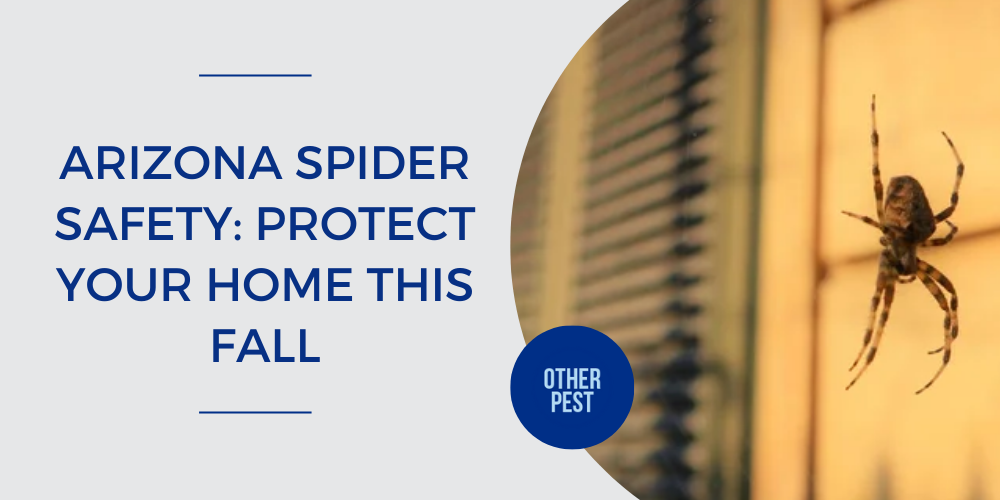As the cooler temperatures start to roll in and Halloween decorations are creeping into our neighborhoods, it’s a good time to talk about spiders. The cobwebs and eerie eight-legged creatures crawling the exterior home walls may not be real, but the spiders spinning webs on patios and door jams, working their way inside through cracks and doorways are very real. Spooky decorations are all about fun, while the reality is that fall is the prime time for increased spider activity. To stay safe during the fall months, learning what to look out for and how to keep spiders away is paramount.
Spiders 101
Spiders belong to the class Arachnida, making them relatives of scorpions, ticks and mites. With eight legs and a body divided into two parts, spiders are distinct from insects. While spiders may look spooky and intimidating, most are harmless to humans and play a crucial role in nature.
Arizona’s Spider Scene: Who’s Living in Your Backyard?
Arizona is home to a wide variety of spiders, many of which benefit the local ecosystem. These arachnids help keep insect populations in check and play a crucial role in balancing the food chain. While these facts may be comforting, spider sightings still tend to evoke fear.
Most spiders are tiny and go unnoticed, hiding in corners inside and outside the home. Spiders are also timid creatures and prefer to avoid human contact unless provoked. However, a few species can pose major health risks to humans when bitten, so it’s important to be able to identify the different types and know how to handle the situation if/when you have an encounter.
Common Spiders in Arizona
Desert tarantula: Tarantulas are perhaps the most misunderstood spiders in Arizona. Despite their large, scary, hairy appearance, they are among the least dangerous spiders you’re likely to see. Tarantulas are calm creatures that rarely bite humans. In fact, they are more likely to show their fangs as a warning before taking any aggressive action. If left undisturbed, tarantulas will quietly move along without causing any issues.
Jumping spiders: These tiny, colorful spiders are often spotted on windowsills, in gardens and inside homes. They are known for their excellent vision and impressive jumping abilities and they are harmless to humans. Jumping Spiders are more curious than aggressive and pose no significant risk.
Wolf spiders: These ground-dwelling hunters do not spin webs to trap their prey in, but actively chase it instead. They are fast and can look scary, but bites are rare and generally harmless.
Arizona’s Most Dangerous Spiders
While most spiders are harmless, there are a few species living in Arizona that pose health risks to humans and pets:
Black widow: The black widow is perhaps the most infamous spider there is. While there are three types found in the United States, only the Western black widow, calls Arizona home. Females are easily recognized by their shiny black body and distinctive red hourglass shape on the underside of their abdomen. Male black widows are usually brown or gray with small red spots on their abdomen. Black widows prefer dark, sheltered areas such as a woodpile, under patio furniture or in a garage. They are not aggressive, but if disturbed or provoked they are likely to bite.
Male black widows are not dangerous, but females are highly venomous. The female’s venom attacks the nervous system and reactions typically occur within minutes but can take up to an hour. Symptoms include extreme pain around the bite, muscle cramps/spasms, nausea and difficulty breathing, to name a few. If you think you’ve been bitten by a black widow, seek medical attention immediately to manage the symptoms, especially if you’re experiencing severe pain or have underlying health issues.
Arizona brown spider: Closely related to the dreaded brown recluse, the Arizona brown spider is what you’ll find in Arizona. Less common than the black widow, this recluse has a violin-shaped marking on the op of its head and is about the size of a nickel up to a quarter. Arizona brown spiders like to keep to themselves in dark, quiet outdoor areas. They typically avoid human interaction, but their venom can cause necrosis if enough is injected, so it’s important to consult a physician immediately after a suspected bite. Other symptoms include intesne pain and itching, open sores or reddened skin around the bite, as well as fever, nausea and joint pain.
Why October is Spider Season
While spiders are active year-round in Arizona, their activity peaks in the fall. Cooling temperatures drive many spiders to seek warmth and shelter inside homes, garages and sheds. Fall is also mating season for many spider species, including tarantulas. You may notice more male tarantulas wandering around as they search for mates. Don’t be too spooked if you discover a spider crawling up a wall or across the floor — remember, most species are harmless and they are simply adapting to the change in weather.
How to Prevent Spiders in Your Home
While most spiders pose little to no danger, most people don’t want them in or around their homes. Here are a few simple tips to keep spiders out of your living space this season:
Seal entry points: Spiders can sneak into your home through small gaps and cracks in doors, windows, and walls. Ensure all entry points are properly sealed and use weather stripping where necessary.
Declutter and clean regularly: Spiders love dark, cluttered areas where they can hide undisturbed. Keep storage spaces such as closets, sheds and garages organized and clean. Regular vacuuming and clear out spider webs in and around the home to help remove egg sacs.
Limit use of outdoor lighting: Lights attract insects, in turn attracting spiders who feed on insects. If possible, turn off outdoor lights when not in use or use yellow “bug lights” that are less likely to attract insects.
Use natural repellents: Essential oils like peppermint, lavender, and eucalyptus are known to repel spiders. Spraying a diluted mixture of these oils around windows, door frames and baseboards can help keep spiders at bay.
What to Do if You Find Spiders in Your House
If you encounter a spider in your home, there’s no need to panic. Rest assured knowing it isn’t necessary to grab a nearby shoe to eliminate the eight-legged intruder. Most spiders can be safely captured using a jar or a piece of paper and transported outdoors. However, if you suspect the unwanted visitor is a black widow or brown recluse, be very careful to eliminate as quickly as possible. Then, consider a visit to one of our Bug & Weed Mart stores to speak with one of our experts about proper products and strategies to keep spiders and other unwanted pests away.
What to Do if You Encounter a Dangerous Spider
Even when you seal cracks around your home, sprinkle granules around the perimeter of your home and remove clutter, you may still unexpectedly discover a venomous spider. This is especially possible when cleaning out a garage, other storage spaces or when enjoying time outdoors. To keep yourself and your family safe, we recommend the following:
Shake out clothes and shoes
It’s a good habit to shake out your clothes and shoes before wearing them, especially if they’ve been sitting out for a while. Spiders love to hide in undisturbed areas like closets, drawers and laundry piles. A quick shake can remove any spiders that may have crawled in, keeping you safe from unexpected bites.
Wear protective materials:
When handling stored items, working in the garden, or clearing out dark corners of a garage or cabinet, always wear gloves. Gloves provide a protective barrier in case you accidentally disturb a hidden spider.
Stay calm
Remember not to panic. Most spiders, including black widows and Arizona brown spiders, won’t bite unless provoked. If you see a spider, avoid sudden movements, then determine if you can remove or allow it space to safely move away.
Spiders are inhabitants of our Arizona landscape. As we head into the fall season and they begin to look for ways to come inside, it is important to take necessary steps to keep them out of your home. By understanding the common species in your area and learning how to identify and safely remove them, you can better protect and prevent more frequent encounters. If you have any questions about what types of spiders you are seeing or how to keep them out, stop by one of our Valley-wide locations and one of our pest experts will happily assist you.

